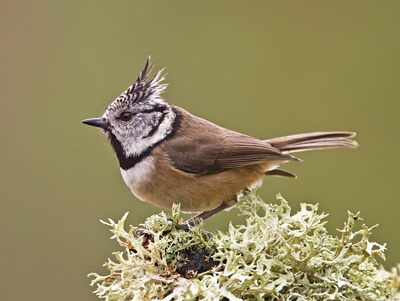
Crested Tit Photo: Nigel Sprowell
The Scottish Highlands are one of the last truly wild places in the United Kingdom. The imposing Grant Arms Hotel, home to The Birdwatching and Wildlife Club with its own Club room, wildlife information center, bookshop and natural history library, is ideally placed to explore the region. From this comfortable hotel we’ll venture out each day to a different part of the region seeking out its very special birds and mammals. Early spring is an excellent time to go birding here as summer visitors will be arriving while at least a few winter birds linger on.
For the final few days, we’ll move to the west coast and the magical island of Mull. The scenery is stunning and we should get fantastic views of White-tailed Eagle and a range of other raptors and seabirds, and perhaps Otter.
Day 1: The tour begins this afternoon at the Grant Arms Hotel, Grantown-on-Spey.
Days 2–6: We’ll explore the rich and varied habitats found within a day’s travel of our comfortable base. There will be no fixed itinerary, responding instead to the weather and reports of local sightings. Loch Garten is, of course, one destination we’ll visit at least once with hopes of seeing its famous Osprey, and the dense woodland that surrounds the loch hold the dainty Crested Tit, Redpoll, Treecreeper, Siskin, and Tree Pipit. Separating Scottish and Common Crossbills is only possible using sound recording - even then there is uncertainty, and it is likely that the two species will be considered one in future taxonomic revisions. In recent years Parrot Crossbill has also become established, and we’ll spend some time trying to locate them. These woods are also the haunt of a giant – the majestic Capercaillie. However, for all their size, they are extremely shy and secretive, and catching sight of one is far from easy. The Capercaillie is declining rapidly and they are easily disturbed, so we’ll restrict our visit to established forest tracks and avoid areas that are known to be sensitive for Capercaillie. Locating one will take great good luck. Much more obvious will be Red Squirrels bounding through the branches, and the Goldeneye and Red-breasted Mergansers out on the loch.
We’ll visit Loch Ruthven where we may find a pair of stunning Slavonian Grebes or Red-throated Divers. Near the hotel, as dusk falls we’ll certainly hear, and hopefully see, Woodcock performing their distinctive ‘roding’ dsiplays and we will visit a hide in the hope of seeing an elusive Pine Marten or a badger.
The Cairngorms create an impressive backdrop to our time on Speyside. Formed 400 million years ago it is one of the most spectacular parts of Britain and the largest landmass over 3000 feet, covering an area of over 200 square miles. We’ll visit the national park’s car park where we expect to see Snow Buntings foraging, as well as hopefully Mountain Hare on the lower slopes. On nearby local moorlands Red Grouse will explode from our feet but stealth and care will be needed to catch sight of the much rarer and elegant Black Grouse or a smart Ring Ouzel.
The nearby Moray Firth will also be worth a visit. About 40 minutes’ drive from our base we stand a good chance of finding Bottle-nosed Dolphins, and both Common and Grey Seals just offshore. There could be a few remaining winter seaduck such as Scaup, Common or Velvet Scoter and Long-tailed Duck mingling with the local Common Eider, and the open sea is a popular fishing location for the local Ospreys.
Findhorn Valley is known as the Valley of the Raptors – and for good reason. During our time here we could encounter Golden Eagle, Peregrine, Merlin, Common Buzzard and even a ghostly male Hen Harrier. The river running along the valley floor is home to Dipper, Common Sandpiper, Common Tern, and Grey Wagtail.
Another day could be spent on the Black Isle, north of Inverness. Here Red Kites abound, and the coastal stretches are another great place to look for sea mammals, as well as Gannets and the odd Arctic Skua. In Munlochy Bay we’ll seek out local residents such as Curlew, Shelduck, Oystercatcher, and Redshank. More seabirds can be found at Troup Head where the only mainland Gannet colony in Scotland shares the cliff faces with Fulmars, Shags, Kittiwakes, Guillemots, Razorbills and Puffins. Nights at the Grant Arms Hotel.
Days 7-9: We’ll drive across to the west coast, making a few stops along the way to look for any target species yet to be seen. A short ferry trip takes us across to the fabulous island of Mull which is recognized as a leading wildlife destination. During the ferry crossing there will be the chance of Black Guillemot and we’ll keep an eye out for Grey Seals and cetaceans.
Mull is home to the majestic White-tailed Eagle and here we can expect good views of these amazing birds, along with a host of other raptor species such as Golden Eagle and Hen Harrier. There is a good population of Otter on the island, and we’ll spend some time checking kelp beds along the shore to get views of these elusive mammals. We’ll take an unforgettable boat trip to the Treshnish Isles where we can expect close up views of Puffins. Cetaceans and Minke Whales are possible as we make our way between the islands. Nights on the Isle of Mull.
Day 10: We’ll return to the east coast with regular stops at a wide variety of habitats bringing this tour to a wonderful conclusion. Night in Inverness.
Day 11: The tour ends this morning after breakfast.
Updated: 23 April 2024
Prices
- 2025 Tour Price : $3,950
- Single Occupancy Supplement : $680
Notes

Questions? Tour Manager: Stephanie Schaefer. Call 1-866-547-9868 (US or Canada) or (01) 520-320-9868 or click here to email.
* Tour invoices paid by check carry a 4% discount. Details here.
Maximum group size seven with one leader.
